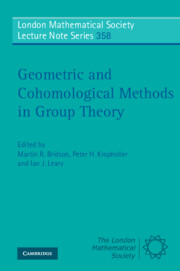Book contents
- Frontmatter
- Contents
- Preface
- List of Participants
- Notes on Sela's work: Limit groups and Makanin-Razborov diagrams
- Solutions to Bestvina & Feighn's exercises on limit groups
- L2-Invariants from the algebraic point of view
- Constructing non-positively curved spaces and groups
- Homology and dynamics in quasi-isometric rigidity of once-punctured mapping class groups
- Hattori-Stallings trace and Euler characteristics for groups
- Groups of small homological dimension and the Atiyah conjecture
- Logarithms and assembly maps on Kn(Zl[G])
- On complete resolutions
- Structure theory for branch groups
Constructing non-positively curved spaces and groups
Published online by Cambridge University Press: 07 September 2011
- Frontmatter
- Contents
- Preface
- List of Participants
- Notes on Sela's work: Limit groups and Makanin-Razborov diagrams
- Solutions to Bestvina & Feighn's exercises on limit groups
- L2-Invariants from the algebraic point of view
- Constructing non-positively curved spaces and groups
- Homology and dynamics in quasi-isometric rigidity of once-punctured mapping class groups
- Hattori-Stallings trace and Euler characteristics for groups
- Groups of small homological dimension and the Atiyah conjecture
- Logarithms and assembly maps on Kn(Zl[G])
- On complete resolutions
- Structure theory for branch groups
Summary
Abstract
The theory of non-positively curved spaces and groups is tremendously powerful and has enormous consequences for the groups and spaces involved. Nevertheless, our ability to construct examples to which the theory can be applied has been severely limited by an inability to test – in real time – whether a random finite piecewise Euclidean complex is non-positively curved. In this article I focus on the question of how to construct examples of non-positively curved spaces and groups, highlighting in particular the boundary between what is currently do-able and what is not yet feasible. Since this is intended primarily as a survey, the key ideas are merely sketched with references pointing the interested reader to the original articles.
Over the past decade or so, the consequences of non-positive curvature for geometric group theorists have been thoroughly investigated, most prominently in the book by Bridson and Haefliger [26]. See also the recent review article by Kleiner in the Bulletin of the AMS [59] and the related books by Ballmann [4], Ballmann-Gromov-Schroeder [5] and the original long article by Gromov [48]. In this article I focus not on the consequences of the theory, but rather on the question of how to construct examples to which it applies. The structure of the article roughly follows the structure of the lectures I gave during the Durham symposium with the four parts corresponding to the four talks.
- Type
- Chapter
- Information
- Geometric and Cohomological Methods in Group Theory , pp. 162 - 224Publisher: Cambridge University PressPrint publication year: 2009
- 3
- Cited by

